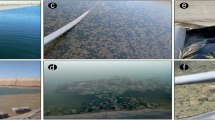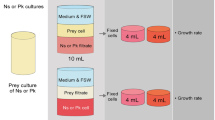Abstract
The population dynamics of harmful microalgae was investigated in the semi-enclosed shallow lagoon, Tunis northern lagoon (South Mediterranean), during a 1-year period from January to December 2007. A total number of 16 potentially toxic dinoflagellates were identified. Density of each species was analyzed in time and space and in relation to environmental parameters. Some species such as Alexandrium catenella, A. pseudogonyaulax, A. tamarense, Dinophysis sacculus, Prorocentrum lima, P. minimum and Gonyaulax spinifera developed high cell concentrations, particularly during spring and summer seasons. Other species such as A. insuetum, A. lee, A. minutum, Coolia monotis, D. acuminata, D. caudata, D. fortii, Ostreopsis siamensis and P. concavum were detected in this coastal ecosystem, but they were rare or appeared in very low densities.
Densities of the most abundant species were closely associated with spring and summer conditions, being positively correlated with water temperature and salinity. These species performed well in this lagoon, but the specific species-dependent affinity to each of the environment factors determined which organisms proliferated. The spatial distribution of the abundant species exhibited a marked increase towards the western and southern parts of the lagoon represented by sites C, D and E. Examination of the temporal distribution revealed that the species more prone to bloom are those with extensive spatial distribution and frequent presence throughout the year such as D. sacculus.
Statistical analysis of D. sacculus density dynamics showed a significant difference between summer and winter assemblages. It presented a positive correlation with water temperature and salinity, but it seems to be tolerant to all levels of nutrients.
Similar content being viewed by others
References
Anderson D.M. and Keafer B.A. 1985. Dinoflagellate cyst dynamics in coastal and estuarine waters. In: Anderson D.M., White A.W. and Baden D.G. (eds), Toxic dinoflagellates. Elsevier, New York, pp 219–224.
Anderson D.M., Glibert P.M. and Burkholder J.M. 2002. Harmful algal blooms and eutrophication: nutrient sources, compositionn, and consequences. Estuaries 25, 704–726.
Annabi-Trabelsi N., Trabelsi E.B., Daly Yahia M.N., Ben Maïz N. and Romdhane M.S. 2003. Preliminary evaluation of the trophic status of the north lake of Tunis waters: application of the Trophic index (TRIX). Water Waste and Environment Research 4, 39–46.
Arjen H. and Oostinga H. 1992. North Lake of Tunis and its shores: restoration and development. Terra e Aqua 23–32.
Armi Z., Turki S., Trabelsi E. and Ben Maïz N. 2008. Nutrient loading and occurrence of potentially harmful phytoplankton species in the North Lake of Tunis (Tunisia). Cahiers de Biologie Marine 49, 311–321.
Armi Z., Turki S., Kacem I., Ben Maïz N., Bouaïcha N. and Hajjem B. 2009. Accidentally Appearance of the dinoflagellate Kryptoperidinium foliaceum (Stein 1883) in Tunis north lagoon. Revue de la Faculté des Sciences de Bizerte 6, 35–42.
Armi Z., Turki S., Trabelsi E. and Ben Maïz N. 2010a. First recorded proliferation of Coolia monotis (Meunier, 1919) in the North Lake of Tunis (Tunisia). Environmental Monitoring and Assessment 164, 423–433.
Armi Z., Trabelsi E., Turki S., Béjaoui B. and Ben Maïz N. 2010b. Seasonal phytoplankton responses to environmental factors in a shallow Mediterranean lagoon. Journal of Marine Science and Technology 15, 417–426.
Badylak S. and Philips E.J. 2004. Spatial and temporal patterns of phytoplankton composition in a subtropical coastal lagoon, the Indian River Lagoon, Florida, USA. Journal of Plankton Research 26, 1229–1247.
Balech E. 1988. Los Dinoflagelados del Atlantico sudoccidental. Publicaciones Especiales Instituto Español de Oceanografia 1, 1–31.
Balech E. 1995. The Genus Alexandrium Halim (Dinoflagellata). Sherkin Island Marine Station, Sherkin Island Co., Cork, Ireland, 151 pp.
Ben Charrada R. 1992. Le lac de Tunis après les aménagements. Paramètres physico-chimiques de l’eau et relation avec la croissance des macro-algues. Marine Life 1, 29–44.
Ben Charrada R. 1995. Impact des aménagements de restauration sur la qualité des eaux et des peuplements benthiques du lac de Tunis. Marine life 5, 51–64.
Ben Maïz N. 1993. Evolution des peuplements phytobenthiques après les travaux d’assainissement du lac nord de Tunis. In: Boudouresque, C.F., Pergent-Martini, C., (Eds.), Qualité du milieu marin, indicateurs biologiques et physicochimiques. GIS Posidonie publication, France, pp. 89–104.
Britton R.H. and Crivelli A.J. 1993. Wetlands of southern Europe and North Africa: Mediterranean wetlands. In: Whigman D.F., Dykyjová D. and Hejný S. (eds), Wetlands of the World I: Inventory, Ecology and Management. Handbook of Vegetation Science. Kluwer Academic Publishers, The Netherlands, pp 129–194.
Cabrini M., Cataletto B., Umani S.F. and Ramani P. 1995. Identification of a lagoon phytoplankton community by multivariate analysis. In: Ravera O. and Anelli A. (eds), VI Congr. Naz Societá Italiana di Ecologia, Venezia, pp 181–185.
Cembella A.D., Ibarra I.A., Diogene J. and Dahl E. 2005. Harmful algal blooms and their assessment in fjords and coastal embayments. Oceanography 18, 158–171.
Clarke K.R. (1993) Non-parametric multivariate analyses of changes in community structure. Australian journal of Ecology 18, 117–143.
Clarke K.R. and Warwick R.M. 2001. Changes in marine communities: an approach to statistical analysis and interpretation, 2nd edition. Plymouth, UK, Plymouth Marine Lboratory, PRIMER-E.
Collos Y., Gagne C., Laabir M., Vaquer A., Cecchi P. & Souchu P. 2004. Nitrogenous nutrition of Alexandrium catenella (Dinophycea) in cultures and in Thau lagoon, southern France. J. Phycol., 40: 96–103.
Delmas D., Herbland A. and Maestrini S.Y. 1992. Environmental conditions which lead to increase in cell density of the toxic dinoflagellates Dinophysis spp. in nutrient-rich and nutrient-poor waters of the French Atlantic coast. Marine Ecology Progress Series 89, 53–61.
Dolapsakis N.P., Tzovenis I., Kantourou P., Bitis I. and Economou-Amilli A. 2008. Potentially harmful microalgae from lagoons of the NW Ionian sea, Greece. Journal of Biological Research-Thessaloniki 9, 89–95.
Garcés E., Masó M. and Camp J. 1999. A recurrent and localized dinoflagellate bloom in a Mediterranean beach. Journal of Plankton Research 21, 2373–2391.
Garcés E., Masó M., Vila M. and Camp J. 2000. HABs events in the Mediterranean Sea: are they increasing? A case study the last decade in the NW Mediterranean and the genus Alexandrium. Harmful Algal News 20, 1–11.
Giacobbe M.G., Penna A., Ceredi A., Milandri A., Poletti R. and Yang X. 2000. Toxicity and ribosomal DNA of the dinoflagellate Dinophysis sacculus (Dinophyta). Phycologia 39, 177–182.
Godhe A., Svensson S. and Rehnstam-Holm A.S. 2002. Oceanographic settings explain fluctuations in Dinophysis spp. and concentrations of diarrhetic shellfish toxin in the plankton community within a mussel farm area on the Swedish west coast. Marine Ecology Progress Series 240, 71–83.
Hallegraeff G.M. 1993. A review of harmful algal blooms and their apparent Global increase. Phycologia 32, 79–99.
Harrison W.G. 1976. Nitrate metabolism of the red tide dinoflagellate Gonyaulax polyedra Stein. Journal of Experimental Marine Biology and Ecology 21, 9–209.
ICES 2005. Report of the ICES-IOC Working Group of Harmful Algal Bloom Dynamics (WGHABD), 4–7 April 2005, Flodevigen, Norway. C03 Re. ACME, ACE.
Imai I., Yamaguchi M. & Hori Y. 2006. Eutrophication and occurrences of harmful algal blooms in the Seto Inland Sea, Japan. Plankt. Benthos Res., 1(2): 71–84.
Jacobson D.M. and Andersen R.A. 1994. The discovery of mixotrophy in photosynthetic species of Dinophysis (Dinophyceae): light and electron microscopical observations of food vacuoles in Dinophysis acuminata, D. norvegica and two heterotrophic dinophysoid dinoflagellates. Phycologia 33, 97–100.
Lindahl O. 1986. A divided hose for phytoplankton sampling. ICES, C. M. L 26, Annex 3.
López-Flores R. 2005. Phytoplankton dynamics in permanent and temporary waters of Empordá salt marshes (NE Spain). PhD Thesis. Universitat de Girona, Spain.
Margalef R. 1983. Limnologia. Omega, SA, Barcelona, Spain, 1010 pp.
Matsuoka K. and Fukuyo Y. (2000) Technical guide for modern dinoflagellate cyst study. WESTPAC-HAB/WESTPAC/IOC.
Nedwell D.B., Dong L.F., Sage A. and Underwood G.J.C. 2002. Variations of the nutrients loads to the mainland U.K. estuaries: correlation with catchment areas, urbanization and coastal eutrophication. Estuarine, Coastal and Shelf Science 54, 951–970.
Parsons T.R., Maita Y. and Lalli C.M. 1984. A manual of chemical and biological methods for seawater analysis. Pergamon Press, Oxford.
Peña-Manjarrez J.L., Helenes J., Gaxiola-Castro G. and Orellana-Cepeda E. 2005. Dinoflagellate cysts and bloom events at Todos Santos Bay, Baja California, Mexico, 1999-2000. Continental Shelf Research 25, 1375–1393.
Pérez-Ruzafa A., Gilabert J., Gutiérrez J.M., Fernández A.I. and Marcos C. 2002. Evidence of a planktonic food web response to changes in nutrient input dynamics in the Mar Menor coastal lagoon, Spain. Hydrobiologia 359-369, 475–476.
Picot B., Pena G., Casellas C., Bondon D. and Bontoux J. 1990. Interpretation of the seasonal variations of nutrients in a mediterranean: Etang de Thau. Hydrobiologia 207, 105–114.
Quintana X.D. and Moreno-Amich R. 2002. Phytoplankton composition of Emporda` salt marshes, Spain and its response to freshwater flux regulation. Journal of Coastal Research 36, 581–590.
Quintana X.D., Moreno-Amich R. and Comín F.A. 1998. Nutrient and plankton dynamics in a Mediterranean salt marsh dominated by incidents of flooding. Part. I. Differential confinement of nutrients. Journal of Plankton Research 20, 2089–2107.
Ranston E.R., Webber D.F. and Larsen J. 2006. The first description of the potentially toxic dinoflagellate, Alexandrium minutum in Hunts Bay, Kingston Harbour, Jamaica. Harmful Algae 16, 29–47.
Reynolds C.S., Huszar V., Kruk C., Naselli-Flores L. and Melo S. 2002. Towards as functional classification of the freswater phytoplankton. Journal of Plankton Research 24, 417–428.
Riegman R. 1991. Mechanisms behind eutrophication-induced novel algal blooms. Neth. Inst. Journal of Sea Research 9, 1–51.
Sarno D., Zingone A., Saggiomo V. and Carrada G.C. 1993. Phytoplankton biomass and species composition in a Mediterranean coastal lagoon. Hydrobiologia 271, 27–40.
Smayda T.J. and Reynolds C.S. 2003. Strategies of marine dinoflagellate survival and some rules of assembly. Journal of Sea Research 49, 95–106.
Sournia A. 1995. Red tide and toxic marine phytoplankton of the world ocean: an inquiry into biodiversity. In: Lassus P., Arzul G., Erard E., Gentien P. and Marcailou-Le Baut C. (eds) Harmful marine algal blooms, pp 103–112.
Steidinger K.A. and Tangen K. 1997. Dinoflagellates. In: Tomas C.R. (eds), Identifying Marine Phytoplankton, Academic Press, St. Petersburg, Florida, USA, pp 387–584.
Throndsen J. 1995. Estimating cell numbers. In: Hallegraeff G.M., Anderson D.M., Cembella A.D. and Enevoldsen H.O. (eds), Manual on Harmful Marine Microalgae, IOC Manual and Guides No. 33. UNESCO, Paris, pp 63–80.
Todd E.C.D. 1993. Domoic Acid and Amnesic Shellfish Poisoning — A Review. Journal of Food Protection 56, 69–83.
Trabelsi E.B., Shili A. and Ben Maïz N. 2001. Marine flora of the north lake of Tunis 12 years after its restoration. In: Özhan (eds), Proceedings of the fifth international conference on the Mediterranean coastal environment, MEDCOAST 01. Middle East Technical University, Ankara 2, 916–92.
Turki S. 2004. Suivi des microalgues planctoniques toxiques dans les zones de production, d’élevage des mollusques bivalves et d’exploitation des oursins du nord de la Tunisie. Bulletin de l’Institut National des Sciences et Technologie de la Mer de Salammbô 31, 83–96.
Turki S. and Balti N. 2005. Detetion of toxic Alexandrium catenella (Whedon & Kofoid) Balech in clam production zone of North Lake and Channel, Tunisia. Harmful Algae News 28, 1–2.
Utermöhl H. 1958. Zur vervolkommung der qualitativen Phytoplankton metodik. Mitteil Inter Verein Limnologie 9, 1–38.
Vila M., Camp J., Garcés E., Masó M. and Delgado M. 2001. High resolution spatio-temporal detection of potentially harmful dinoflagellates in confined waters of the NW Mediterranean. Journal of Plankton Research 23, 497–514.
Work T.M., Barr B., Beale A.M., Fritz L., Quilliam M.A. and Wright J.L.C. 1993. epidemiology of domoic acid poisoning in Brown Pelicans (Pelecanus occidentalis) and Brandt Cormorants (Phalacrocorax penicillatus) in California. Journal of Zoo and Wildlife Medicine 24, 54–62.
Zaouali J. 1977. Le lac de Tunis: facteurs climatiques, physicochimiques et crises dystrophiques. Bulletin de l’Office National des Pêches de Tunisie 1, 37–49.
Author information
Authors and Affiliations
Corresponding author
About this article
Cite this article
Zina, A., Elbahri, T., Souad, T. et al. Composition and dynamics of potentially toxic dinoflagellates in a shallow Mediterranean lagoon. Ocean and Hydro 41, 25–35 (2012). https://doi.org/10.2478/s13545-012-0036-9
Received:
Accepted:
Published:
Issue Date:
DOI: https://doi.org/10.2478/s13545-012-0036-9




